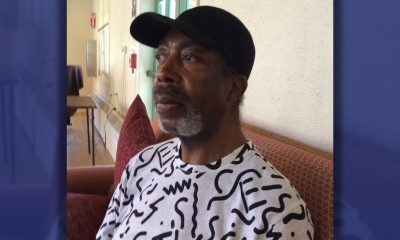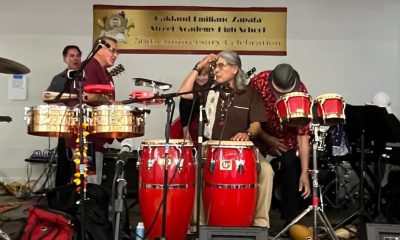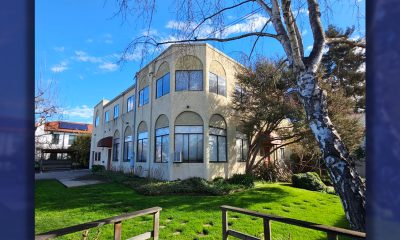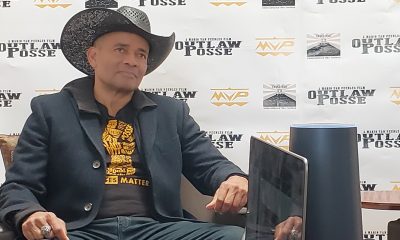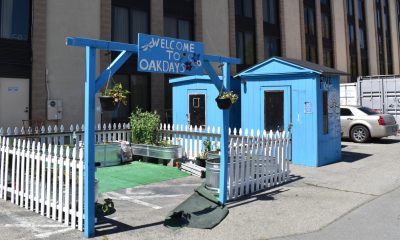Bay Area
CalTrans Enforces Clearance in Oakland, Protestors Help Some Residents Stay
“They posted signs saying everyone had to get off the property”

While facing intense rain and protests on January 27 and 28, California Highway Patrol officers and California Dept. of Transportation (CalTrans) workers cleared tents, trash, broken branches, and homeless people from a tract of CalTrans-owned land that sits between Mosswood Park and the 580 Freeway in North Oakland.
CalTrans referred to the operation as a cleaning. Activists, local civil rights lawyers, and the site’s residents called it an eviction. Two residents successfully resisted being removed from the site and stayed on the tract of land.
“They posted signs saying everybody has to get off the property,” said Osha Neumann, a lawyer with the East Bay Community Law Center who was at the tract on January 27. “To me, that’s an eviction. There’s no question the intent was to displace people.”
CalTrans posted a NO TRESPASSING notice on January 25. Printed words stated the site was scheduled for cleaning on January 27. The date “1/28/21” was also added in blue pen ink.
In an e-mail to Oakland resident Charlotte Ashlock, who inquired about the operation, CalTrans Deputy District Administrator Cheryl Chambers claimed a resident was tapping into a CalTrans electrical panel, which affected 30 streetlights in the area and initiated the clearance.
“During the pandemic, CalTrans is only moving people…if there is an emergency to life or infrastructure as happened with the electrical tap at Mosswood” she wrote.
Caltrans public information officer Janis Mara told The Oakland Post that the cleaning was done because “illegally compromising electrical components poses a fire hazard to those in the area and threatens the integrity of the infrastructure.”
Neumann believes, despite the illegal tapping, CalTran’s actions were not fair to the residents. “Making everybody leave because somebody tapped into electricity is like requiring everybody in an apartment complex to vacate because one tenant is running an illegal extension cord out the window to a socket in the basement,” he said.
By January 29, the vast majority of the tract’s residents moved about 40-60 feet away into Mosswood Park. Mara reported that “Caltrans requested assistance from the City of Oakland to provide social services and outreach in advance of this removal,” but no residents reported being offered alternative shelter.
Two residents, who lived in a small home they had made mostly out of recycled wood and plastic, remained in their home and on the site despite the order to leave. John, who lives in the home, thinks it is not a threat to CalTrans or public health.
The Caltrans-owned tract of land where John’s home sits is smaller than the tennis court it rests behind and is forested with pine and acacia trees. John said he has been on the site on and off for five years because it’s “out of the way.” During the warmer months, thick foliage often makes the area invisible to those outside of it.
On January 27, John and his roommate told CalTrans workers and CHP Offices that they did not plan on leaving. About a half dozen protestors supported them that day.
“I’ve just had them move me around enough,” John told The Oakland Post. “They play musical chairs with everybody, give 5% of the people housing, then take it away a few months later.”
John had been cleared from the area before, but he and his roommate stood firm during this operation and protestors aided them. On January 28, about 20 protestors showed up despite heavy rain. Ten of them held colorful wooden shields. Six of the shield holders stood outside. John and his roommate’s home while four others stood outside another resident’s red tent as he gathered his belongings. About a dozen and a half CalTrans workers gathered and cleared trash and tree branches from the area. Occasionally, workers fell in the slippery mud. A few CHP officers monitored.
The resident who lived in the red tent, who asked not to be named for fear of police retaliation, did not resist the clearance. But the protestor’s presence allowed him extra time to clear his possessions. In the past, CalTrans had destroyed possessions he wished to keep in similar operations.
“This has been one of the best times in terms of being able to salvage my possessions because of the help of the volunteers,” he said. “It was nice to have advocates have our back.”
“They’re clearing debris but also some belongings,” said a protestor while holding a shield January 28. They also asked not to be named due to fear of police retaliation.
“We just want to be sure they don’t touch people’s structures. Threatening people’s ability to shelter themselves at a time like this is appalling.”
CalTrans has a documented history of destroying homeless residents’ belongings during clearances. They agreed to pay $5.5 million in February 2020 to settle a lawsuit that Neumann worked on, Sanchez V CalTrans, which accused the department of illegally destroying homeless people’s property during sweeps in Oakland, Berkeley and Emeryville between December 2014 and October 2019. At least 1,200 people in Oakland, Emeryville and Berkeley said CalTrans destroyed their possessions and have filed claims.
According to John, there had been 20 people living on the CalTrans tract, but most left on January 27 due to feeling intimidated. A protestor, Annmarie Baustamente, who was on the track during both days of the clearance said that some residents were absent during the clearance. She saw CalTrans bag and store people’s items that appeared to be worth more than $50 but worried about residents losing other items that had sentimental value. Bustamante, along with several residents, also expressed worry about a resident who uprooted herself and all her belongings due to the clearance days after her partner died. Neumann said he talked to a resident who lost personal artworks and art supplies that were important to him.
Andrea Henson, a lawyer with the Oakland’s Eviction Defense Center who was on the tract on January 28, said she was appalled to see CalTrans throw away a hand-washing station. “If they were doing a cleaning, then shouldn’t the handwashing station have been moved aside or replaced?” she asked.
Caltrans Public Information Officer Janis Mara’s claimed the wash station was “inoperable and beyond repair.” In her e-mail, CalTrans Deputy District Director Cheryl Chambers said the department allowed one resident “to remain onsite due to his health concerns.” Both lawyers who were onsite, Henson and Neumann, said they thought the reason John’s home was not torn down was the protestors’ presence and John and his roommate’s determination to stay.
“The only reason that the house wasn’t torn down was the protest,” said Henson.
During the clearance, Neumann spoke to the commanding officer on-site and tried to persuade him that tearing down John’s home during the storm and under COVID would look bad for CalTrans and harm the residents. Neumann asked for time to work out solutions to problems CalTrans had with the encampment.
“He listened,” said Neumann, “but I didn’t change his mind. What changed his mind was the presence of eviction defenders.”
By February 2, at least three residents had moved back unto the CalTrans owned land.
Bay Area
East Bay Regional Park District Issues Rattlesnake Advisory
The East Bay Regional Park District released an advisory today on rattlesnakes, which emerge from winter hibernation in early spring and become more active. Warm weather can bring more potential for rattlesnake encounters with humans and dogs, particularly along trails and roads.

The Richmond Standard
The East Bay Regional Park District released an advisory today on rattlesnakes, which emerge from winter hibernation in early spring and become more active.
Warm weather can bring more potential for rattlesnake encounters with humans and dogs, particularly along trails and roads.
Visitors are encouraged to avoid hiking alone in case of an emergency, to scan the ground ahead as they walk, jog or ride, stay on trails avoiding tall grass, and to look carefully around and under logs and rocks before sitting down. Keep your dog on your leash to be extra safe, park officials said.
If you encounter a rattlesnake, leave it alone – it is unlawful to capture or harm one. Move carefully and slowly away or around it and give it plenty of space, park officials said.
Those who are bitten by a rattlesnake are instructed to stay calm by lying down with the affected limb lower than the heart, then having someone call 911.
Getting medical attention is critical.
Those bitten should not use tourniquets, “sucking,” or snake bite kits. If you are by yourself, walk calmly to the nearest source of help to dial 911, do not run.
If bitten by any other type of snake, wash the wound with soap and water or an antiseptic and seek medical attention.
Not sure what bit you? Check the bite for two puncture marks (in rare cases one) associated with intense, burning pain, which is typical of a rattlesnake bite. Other snakebites can leave marks without associated burning pain.
The Northern Pacific rattlesnake is the species found in East Bay Regional Parks. Snakes are important to the natural environment, helping to control rodents and other reptile populations. But enjoy them from afar.
For more information, download the Park District’s Common Snakes brochure or watch our Gopher Snake or Rattlesnake video to learn how to tell the difference between rattlesnakes and gopher snakes. Additional information is available at ebparks.org/safety/wildlife-encounters.
Bay Area
Mayor Breed Proposes Waiving City Fees for Night Markets, Block Parties, Farmers’ Markets, Other Outdoor Community Events
Mayor London N. Breed introduced legislation on April 26 to encourage and expand outdoor community events. The first will waive City fees for certain events, making them less costly to produce. The second will simplify the health permitting for special event food vendors through the creation of an annual permit. Both pieces of legislation are part of the Mayor’s broader initiative to bring vibrancy and entertainment to San Francisco’s public right of ways and spaces.

Mayor’s Press Office
Mayor London N. Breed introduced legislation on April 26 to encourage and expand outdoor community events.
The first will waive City fees for certain events, making them less costly to produce. The second will simplify the health permitting for special event food vendors through the creation of an annual permit. Both pieces of legislation are part of the Mayor’s broader initiative to bring vibrancy and entertainment to San Francisco’s public right of ways and spaces.
Outdoor community events are integral to San Francisco’s vibrant culture and sense of community. These events include night markets, neighborhood block parties and farmers markets, and bolster the City’s economy by supporting local businesses and attracting tourists eager to experience San Francisco’s unique charm and food scene.
They offer residents, workers and visitors, opportunities to engage with local artists, musicians, and food vendors while enjoying the San Francisco’s stunning outdoor spaces and commercial corridors.
The legislation will allow for more and new community gatherings and for local food vendors to benefit from the City’s revitalization.
“San Francisco is alive when our streets are filled with festivals, markets, and community events,” said Breed. “As a city we can cut fees and streamline rules so our communities can bring joy and excitement into our streets and help revitalize San Francisco.”
Fee Waiver Legislation
The events that can take advantage of the new fee waivers are those that are free and open to the public, occupy three or fewer city blocks, take place between 8 a.m. and 10 p.m., and have the appropriate permitting from the ISCOTT and the Entertainment Commission.
The applicant must be a San Francisco based non-profit, small business, Community Benefit District, Business Improvement District, or a neighborhood or merchant association. Fees eligible for waiver include any application, permit, and inspection/staffing fees from San Francisco Municipal Transportation Agency, Department of Public Health, Fire Department, Entertainment Commission, and Police Department.
Currently, it can cost roughly anywhere between $500-$10,000 to obtain permits for organized events or fairs, depending on its size and scope. Organizations and businesses are limited to a maximum of 12 events in one calendar year for which they can receive these fee waivers.
Food Vendor Streamlining Legislation
The second piece of legislation introduced will help special event food vendors easily participate in multiple events throughout the year with a new, cost-effective annual food permit. Food vendors who participate in multiple events at multiple locations throughout the year will no longer need to obtain a separate permit for each event. Instead, special event food vendors will be able to apply and pay for a single annual permit all at once.
“Many successful food businesses either begin as pop-up vendors or participate in special events to grow their business,” says Katy Tang, Director of the Office of Small Business. “Giving them the option for an annual special event food permit saves them time and money.”
Currently, food vendors are required to get a Temporary Food Facility (TFF) permit from the Department of Public Health (DPH) in order to participate in a special event, among permits from other departments.
Currently, each special event requires a new permit from DPH ranging from $124-$244, depending on the type of food being prepared and sold. Last year, DPH issued over 1,500 individual TFF permits. With the new annual permit, food vendors selling at more than four to six events each year will benefit from hundreds of dollars in savings and time saved from fewer bureaucratic processes.
“This legislation is a step in the right direction to make it easier for food vendors like me to participate in citywide events,” said Dontaye Ball, owner of Gumbo Social. “It saves on time, money and makes it more effective. It also creates a level of equity.”
Bay Area
Faces Around the Bay: Sidney Carey
Sidney Carey was born in Dallas, Texas. He moved with his family to West Oakland as a baby. His sister is deceased; one brother lives in Oakland. Carey was the Choir Director at Trinity Missionary Baptist Church for 18 years.

By Barbara Fluhrer
Sidney Carey was born in Dallas, Texas. He moved with his family to West Oakland as a baby. His sister is deceased; one brother lives in Oakland.
Carey was the Choir Director at Trinity Missionary Baptist Church for 18 years.
He graduated from McClymonds High with a scholarship in cosmetology and was the first African American to complete a nine-month course at the first Black Beauty School in Oakland: Charm Beauty College.
He earned his License, and then attended U.C., earning a secondary teaching credential. With his Instructors License, he went on to teach at Laney College, San Mateo College, Skyline and Universal Beauty College in Pinole, among others.
Carey was the first African American hair stylist at Joseph and I. Magnin department store in Oakland and in San Francisco, where he managed the hair stylist department, Shear Heaven.
In 2009, he quit teaching and was diagnosed with Congestive Heart Failure. He was 60 and “too old for a heart transplant”. His doctors at California Pacific Medical Center (CPMC) went to court and fought successfully for his right to receive a transplant. One day, he received a call from CPMC, “Be here in one hour.” He underwent a transplant with a heart from a 25-year- old man in Vienna, Austria
Two years later, Carey resumed teaching at Laney College, finally retiring in 2012.
Now, he’s slowed down and comfortable in a Senior Residence in Berkeley, but still manages to fit his 6/4” frame in his 2002 Toyota and drive to family gatherings in Oakland and San Leandro and an occasional Four Seasons Arts concert.
He does his own shopping and cooking and uses Para Transit to keep constant doctor appointments while keeping up with anti-rejection meds. He often travels with doctors as a model of a successful heart-transplant plant recipient: 14 years.
Carey says, “I’m blessed” and, to the youth, “Don’t give up on your dreams!”
-

 Community2 weeks ago
Community2 weeks agoFinancial Assistance Bill for Descendants of Enslaved Persons to Help Them Purchase, Own, or Maintain a Home
-

 Activism4 weeks ago
Activism4 weeks agoOakland Post: Week of April 3 – 6, 2024
-

 Business3 weeks ago
Business3 weeks agoV.P. Kamala Harris: Americans With Criminal Records Will Soon Be Eligible for SBA Loans
-

 Activism3 weeks ago
Activism3 weeks agoOakland Post: Week of April 10 – 16, 2024
-

 Community3 weeks ago
Community3 weeks agoAG Bonta Says Oakland School Leaders Should Comply with State Laws to Avoid ‘Disparate Harm’ When Closing or Merging Schools
-

 Community2 weeks ago
Community2 weeks agoOakland WNBA Player to be Inducted Into Hall of Fame
-

 Community2 weeks ago
Community2 weeks agoRichmond Nonprofit Helps Ex-Felons Get Back on Their Feet
-

 Community2 weeks ago
Community2 weeks agoRPAL to Rename Technology Center for Retired Police Captain Arthur Lee Johnson

